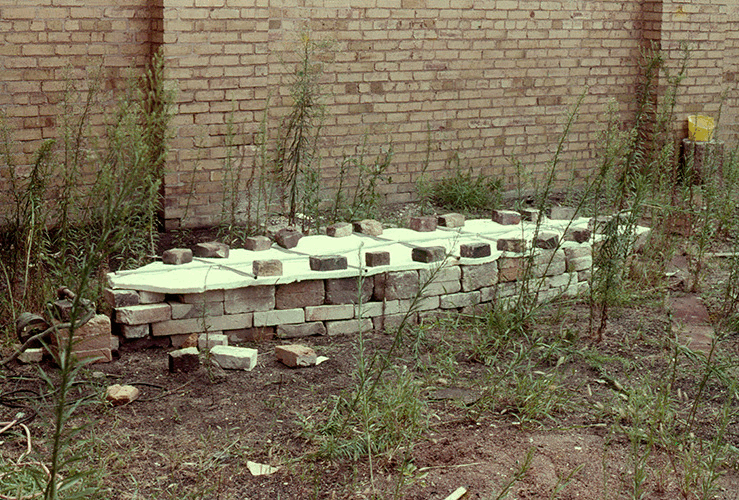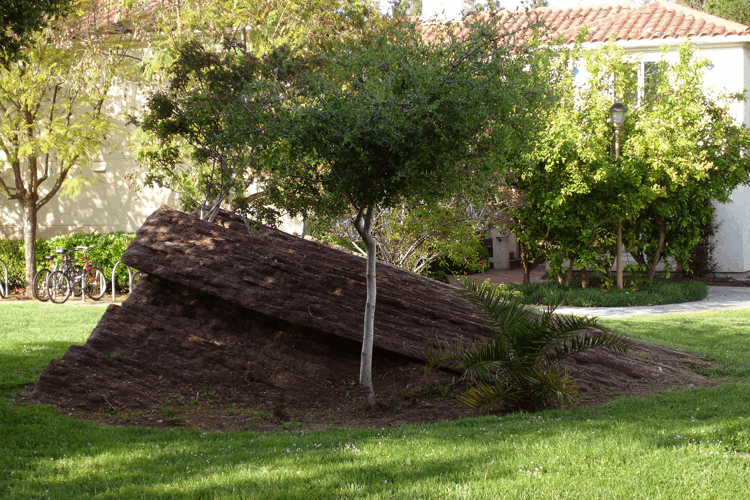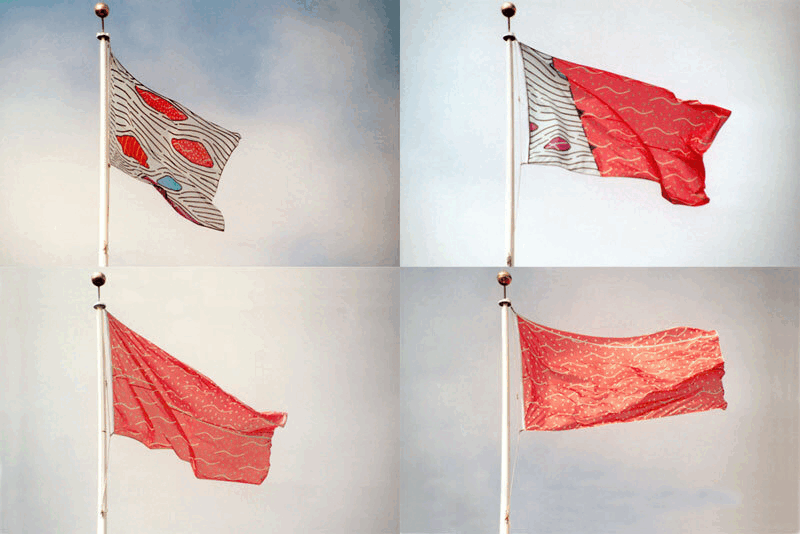
MEMBER SPOTLIGHT
December 11, 2023
This week we recognize artist John Roloff John Roloff and his decades-long investigation of geologic time, sites, and other natural phenomena that began in the late 1960’s, combining poetics and site-specific relationships between material, concept and performance in the domains of ecology, architecture, ceramics, industry, metabolic systems and history.
Fired and Glazed Earth Piece, 1979 (above) is the first larger environmental performance/ kiln work after a series of smaller experimental kilns and firing projects. This work had two stages, the first of purely firing the existing earth in-situ. The second state, is after a second firing and the layered placement of all powdered glaze materials available at the Notre Dame ceramic facility were fused in-situ. In both cases the burner was placed in one end of the kiln, and left to reach a unknown temperature, the purpose being to let the kiln dynamics and natural forces (to the extent possible) determine the state of fusion of the materials, not a pre-determined formula or goal.The work also related to the earthworks projects done by artists of the 1960's and 1970's. Echoing volcanic processes, such as contact metamorphism where a heat source (plutonic intrusion, lava flow, etc) would come into contact with the surrounding native rock and create an altered zone of materials, potential metamorphic facies change in minerology as well as color and texture. The illumination of the ceramic fiber blanket by the heat of the firing, sustaining the kilns ship form at night, became important in developing the spectacle/kiln image dynamic of later projects.
click images for more info

Fragment: The Hidden Sea (Island of Refuge), 1993 (above) is a 35 foot long "artificial" sectioned rock outcrop whose polished front facade is activated by intermittent and distributed seepages of water. An illusion of the art work is that the water is flowing "uphill." The main structure is set into a series of wave-like grass berms, the berms and structure provide sitting and relaxing space for the students of the surrounding housing complex.
"Fragment..." An assemblage of geologic materials and concepts adrift as if broken from a larger system floating in what is a geologically complex and fragmented terrain as in the Franciscan and Great Valley rock sequences that make up much of Western California. These ‘suspect terrains,’ are geologic progressions of ancient sea floor deposited against the original North American continent by accretion processes generated by plate tectonics and oceanic sea-floor spreading over millions of years.
"...(Island of Refuge)" An interactive topography: an ‘outcrop’ sited in a communal terrain, berms for relaxing and reading, the back slope for viewing activities on the adjacent grass expanse, the slow drip of the front facade inviting investigation of its origin and secrets.
"...The Hidden Sea..." A sea that resides in the memory of all sediments deposited in marine and estuarine environments. A sea that once lapped shorelines, that can now only be imagined. A sea that exists within the vast expanses of stratified material making up sedimentary landscapes, its currents and subtle subcurrents persisting in the orientation and gradients of minute lithified particles that drifted and settled to the bottom of the deep oceans. The variable seepage of water from the front facade of Fragment: The Hidden Sea (Island of Refuge) provides a living reminder of these themes, dampening the fossil-like inclusions and waveform strata.

Stratigraphic Column I, 2002 (above) is composed of alternating images taken of Cambrian and Ordovician Era carbonate marine sediments from the Panamint Mountains in Death Valley, California and contemporary buildings (Holocene era) in the process of being deconstructed or having undergone conflagration in northern California. The images have been digitally stretched to form strata-like structures that recompose the column into a sequence of non-conformities and displacement in geologic time and distance. This meta-order examines an intermingling of Holocene and Paleozoic structures over 300 million years and 500 miles (800 kilometers) apart. The geographic displacement from Death Valley to Oakland is on the scale of plate tectonics or large strike/slip or transform fault systems such as the San Andreas Fault in western California. The practice of architecture often brings together materials from even greater distances and time frames for aesthetic, design or structural reasons.

Protogaea Civica II (Franciscan Formation/San Francisco, CA), 2005 (above) is the second and largest of three variations of the Geology Flag Project, a system of symbolic demarcation of site-specific geologic structures and materials using flags. This version uses 19 flag poles at the San Francisco Civic Center Plaza. The flags emblematically identify the Civic Center’s site in relationship to the Franciscan Formation, the bedrock beneath the larger Bay Area, east of the San Andreas Fault. The Civic Center, in geologic terms, rests unconformably (a time gap in deposition) on part of the Franciscan called the Alcatraz Terrane, near its western edge. The complete set of flags are envisioned as a comprehensive system of geo-taxonomy, an indexing and revealing of the geologic materials and structures beneath any given site, and, as flags flying above civic sites, such as the San Francisco Civic Center, staking a claim for the “nationhood” of nature and natural systems. The flags are political, national and regional history flags.
The Sea Within the Land, 1980-2019 (below) are images from Roloff's retrospective exhibition at Anglim Gilbert Gallery in San Francisco, presenting selected kiln documentation, photographic installations, and recent ceramic ships. Utilizing a cross-disciplinary approach to ceramics and performance, his work incorporates the earth and life sciences with architectural and historical elements. The exhibition incorporated a view of the landscape where, in the context of geologic time, the land and sea are mutable, interdependent and may be construed as forms of each other. The processes of erosion and deposition being cyclical inversions of each other, a continuum of land and sea interaction through which new land is constantly being formed. In this fundamental way, land/seascapes are constructed of previous land/seascapes each carrying the blueprint of their ancestor.

John Roloff is a visual artist who works conceptually with site, process and natural systems. He is known for his ceramic works and outdoor kiln/furnace projects done from the 1970’s into the 1990’s, as well as other large-scale environmental projects, gallery installations and objects investigating geologic and natural phenomena. Based on an extensive background and ongoing research in the earth sciences, he works from geochemical and global metabolic perspectives. The ship is a central image of his work, metaphorically evoking psychological and transformative processes of the sea and land in geologic and contemporary time. He studied geology at UC Davis, Davis, CA with Professor Eldridge Moores and others during the formative days of plate tectonics in the late-1960’s. He studied with Louis Marak and received a master’s degree in art in 1973 from CSU Humboldt. In addition to numerous environmental, site-specific installations in the US, Canada and Europe, his work has been included in exhibitions at the Whitney Museum of American Art, UC Berkeley Museum, San Francisco Museum of Modern Art, Smithsonian Institution, Photoscene Cologne and the Venice Architectural and Art Biennales, The Snow Show in Kemi, Finland and Artlantic: wonder, Atlantic City, New Jersey. Art works in the public realm that explore geologic and related concepts can be found at sites such as: Yerba Buena Gardens, San Francisco, CA, University of Minnesota, Minneapolis, MN, I-5 Colonnade Park, Seattle, WA and Stanford University, Palo Alto, CA. He has received three artist’s visual arts fellowships from the NEA, a Guggenheim Foundation fellowship, a California Arts Council grant for visual artists and a Bernard Osher Fellowship at the Exploratorium, San Francisco, CA. He is Professor Emeritus of Sculpture/Ceramics at the San Francisco Art Institute. www.johnroloff.com
Featured images (top to bottom): ©John Roloff, Fired and Glazed Earth Piece, University of Notre Dame, South Bend, IN / 1979, images: Pre-fireing, 12 ft long, fire brick, ceramic fiber blanket, metal tubing, burner, propane, earth and 12 ft long, fire brick, fused and glazed earth beneath kiln / second firing of kiln; Fragment: The Hidden Sea (Island of Refuge) is a35 ft. long, cement, artificial stone, timed water-seepage system, roses, landscaping, Stanford University, Stanford, CA, 1993;Stratigraphic Column I, 2002, an extension of Roloff's Landscape Projection (for an Unknown Window) series, 1998-2001;Protogaea Civica II (Franciscan Formation/San Francisco, CA) 2005, 19 flag poles at the San Francisco Civic Center Plaza as part of the 2005, part of the exhibition, High Five, presented in conjunction with the opening of the new DeYoung Art Museum in Golden Gate Park;The Sea Within the Land 1980-2019; Portrait of the artist.
